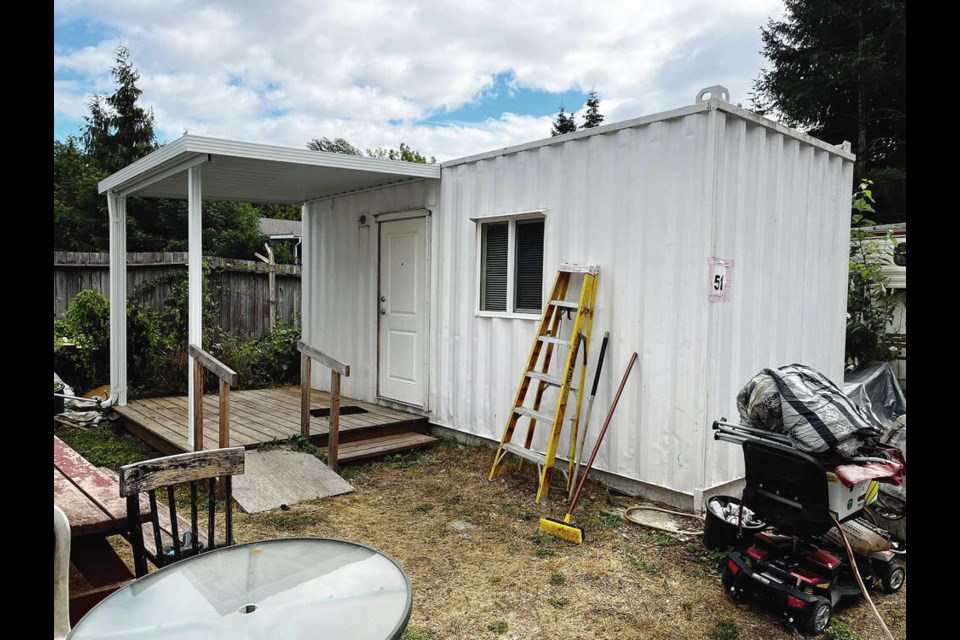A colourful collection of repurposed sea containers is providing homes for people in need in Courtenay.
The non-profit WeCan Shelter Society is in the process of completing its 10th sea can, a bright-yellow structure dubbed “Big Bird” that’s expected to be finished in the next month or so. A turquoise-coloured container is next in line for an extreme makeover.
Each unit has a bed, table, shower, toilet, hot water heater, baseboard heating, kitchen, sink and cooking device and more.
The project was the brainchild of Charlene Davis of Courtenay when she served as president of the Comox Rotary Club in 2019-2020.
A number of factors came together: The club had built projects in the past, sea cans had been successfully converted into homes elsewhere and homelessness had become a serious issue in the community.
Sea cans had another advantage, Davis said. “The cans themselves are virtually indestructible, so any purchase that we made would be one where we could actually maintain the equity in it and that’s not always the case.”
In the first year, three cans were converted to homes, showing the idea could work. “We recognized that there was merit to this, that this was something that was actually a tangible solution to some part of the homeless problem.”
After Davis completed her one-year term with Rotary, the project continued, thanks to the efforts of many volunteers and supporters.
Critical to the project’s success is the support of Jin and Dali Lin, owners of the Maple Pool Campground and RV Park, where the container homes are based.
They are “very benevolent towards people living in poverty and on the edge and have always looked after them,” Davis said. “They are just salt of the earth, wonderful people who do a lot for the community.”
The Lins allow the society to set up containers on a level pad at their property to carry out the work to convert them into homes. “They help us out at any point that they can,” Davis said.
Once completed, the containers join others in the campground, where they are connected to local water and sewer services.
This is not sheltered housing with supports around the clock, Davis said — tenants must be able to live on their own and are chosen by the society and the Lins. Aid workers will at times come in to assist some tenants.
“None of us are social workers. None of us have any psychological or mental-health expertise,” Davis said. “So we have to choose that section of the homeless population that we can help.
“We need to be careful that we don’t put somebody in there whose needs far surpass our ability to meet them.”
Tenants pay $375 per month for pad rental, plus utilities, which normally don’t cost more than $25 per month, Davis said.
Tenants can stay as long as they need to, she said. Some have left to return to school and found more traditional housing. “There’s been some success stories like that.”
But they don’t count success as just people moving on — it’s also seeing people living in safe housing and not outdoors.
Ultimately, Davis would love to see the society buy the campground to continue its work and use a house on the property to provide additional services.
The program does not receive any government funding and is now under the wing of the WeCan Shelter Society, which was established to run it.
It’s supported by a wide range of individuals, businesses, Rotary Clubs and other non-profit social agencies. Volunteers donate time and expertise, businesses provide goods and services for free or at a discounted rate, and non-profits raise money.
Davis praises the local community for its help. “You would not believe how good the people are around this area for giving us money when we need it.”
Volunteer numbers have varied over the years, but today there’s a core group of about 15, Davis said.
Certified tradespeople, such as welders, electricians and plumbers, all work on the containers. Each can is insulated with spray foam insulation, and high-quality industrial hospital-grade flooring is installed.
“We are taking very good care to make sure that these things have a long life cycle.”
To buy and fit out each container costs about $30,000 in total, Davis said. The price would be far more without the donations.
Each 40-foot container comes into the Port of Vancouver and is trucked to welders on Vancouver Island, where it is sliced in half to create a 20-foot-long home. The open end becomes a doorway. The units are eight feet wide and nine-and-a-half feet tall.
The height “makes them much more comfortable for people and more like a home,” Davis said.
“We paint them a really fun, bright colour and then we start putting the interior in place. … They are pretty.”
For more on the society, go to facebook.com/WeCanShelter.
>>> To comment on this article, write a letter to the editor: [email protected]



